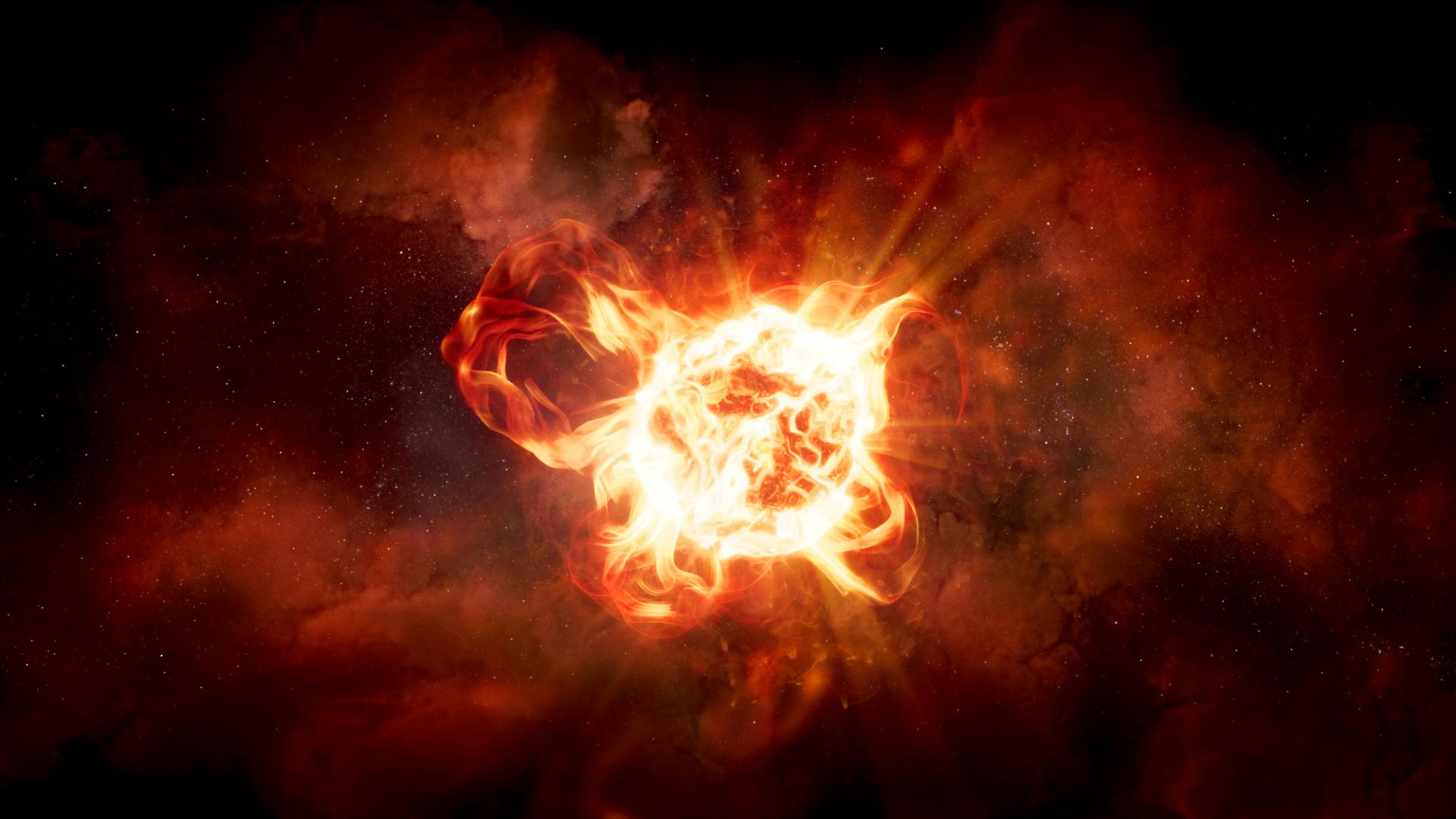
적색거성 VY 큰개자리에 대한 화가의 인상. VY 큰개자리는 지구에서 약 3,009광년 떨어져 있으며 아마도 우리 은하에서 가장 무거운 별일 것입니다. 이미지 제공: NASA/ESA/Hubble/R. Humphreys, University of Minnesota/J. Olmsted, STScI/hublesite.org
천문학자들은 적색거성 VY 큰개자리 주변 유출물에서 분자 방출을 추적함으로써 항성의 대기에 대한 최초의 상세한 지도를 얻었으며, 이 지도는 극단적인 거성의 마지막 단계와 관련된 메커니즘에 대한 정보를 제공합니다.
애리조나 대학이 이끄는 천문학자 팀은 죽어가는 거성의 상세한 3D 이미지를 만들었습니다. UArizona 연구원 Ambesh Singh와 Lucy Ziurys가 이끄는 팀은 VY Canis Majoris로 알려진 적색 거성을 둘러싼 다양한 입자의 분포, 방향 및 속도를 추적했습니다.
2022년 6월 13일 캘리포니아 패서디나에서 열린 미국 천문 학회 240차 회의에서 발표한 그들의 발견은 거성 별의 죽음을 수반하는 과정에 대한 전례 없는 규모의 통찰력을 제공합니다. 공동 작업자는 미네소타 대학교의 로버트 험프리와 영국 맨체스터 대학교의 아니타 리차드였습니다.
극대거성으로 알려진 극단거성 별은 매우 드물며 소수만이 알려져 있습니다.[{” attribute=””>Milky Way. Examples include Betelgeuse, the second brightest star in the constellation Orion, and NML Cygni, also known as V1489 Cygni, in the constellation Cygnus. Unlike stars with lower masses – which are more likely to puff up once they enter the red giant phase but generally retain a spherical shape – hypergiants tend to experience substantial, sporadic mass loss events that form complex, highly irregular structures composed of arcs, clumps, and knots.
Located about 3,009 light-years from Earth, VY Canis Majoris – or VY CMa, for short – is a pulsating variable star in the slightly southern constellation of Canis Major. Spanning anywhere from 10,000 to 15,000 astronomical units (with 1 AU being the average distance between Earth and the sun) VY CMa is possibly the most massive star in the Milky Way, according to Ziurys.
“Think of it as Betelgeuse on steroids,” said Ziurys, a Regents Professor with joint appointments in UArizona Department of Chemistry and Biochemistry and Steward Observatory, both part of the College of Science. “It is much larger, much more massive and undergoes violent mass eruptions every 200 years or so.”
The team chose to study VY CMa because it is one of the best examples of these types of stars.
“We are particularly interested in what hypergiant stars do at end of their lives,” said Singh, a fourth-year doctoral student in Ziurys’ lab. “People used to think these massive stars simply evolve into supernovae explosions, but we are no longer sure about that.”
“If that were the case, we should see many more supernovae explosions across the sky,” Ziurys added. “We now think they might quietly collapse into black holes, but we don’t know which ones end their lives like that, or why that happens and how.”
Previous imaging of VY CMa with NASA’s Hubble Space Telescope and spectroscopy showed the presence of distinct arcs and other clumps and knots, many extending thousands of AU from the central star. To uncover more details of the processes by which hypergiant stars end their lives, the team set out to trace certain molecules around the hypergiant and map them to preexisting images of the dust, taken by the Hubble Space Telescope.
“Nobody has been able to make a complete image of this star,” Ziurys said, explaining that her team set out to understand the mechanisms by which the star sheds mass, which appear to be different from those of smaller stars entering their red giant phase at the end of their lives.
“You don’t see this nice, symmetrical mass loss, but rather convection cells that blow through the star’s photosphere like giant bullets and eject mass in different directions,” Ziurys said. “These are analogous to the coronal arcs seen in the sun, but a billion times larger.”
The team used the Atacama Large Millimeter Array, or ALMA, in Chile to trace a variety of molecules in material ejected from the stellar surface. While some observations are still in progress, preliminary maps of sulfur oxide, sulfur dioxide, silicon oxide, phosphorous oxide and sodium chloride were obtained. From these data, the group constructed an image of the global molecular outflow structure of VY CMa on scales that encompassed all ejected material from the star.
“The molecules trace the arcs in the envelope, which tells us molecules and dust are well-mixed,” Singh said. “The nice thing about emissions of molecules at radio wavelengths is that they provide us with velocity information, as opposed to the dust emission, which is static.”
By moving ALMA’s 48 radio dishes into different configurations, the researchers were able to obtain information about the directions and velocities of the molecules and map them across the different regions of the hypergiant’s envelope in considerable detail, even correlating them to different mass ejection events over time.
Processing the data required some heavy lifting in terms of computing power, Singh said.
“So far, we have processed almost a terabyte from ALMA, and we still receive data that we have to go through to get the best resolution possible,” he said. “Just calibrating and cleaning the data requires up to 20,000 iterations, which takes a day or two for each molecule.”
“With these observations, we can now put these on maps on the sky,” Ziurys said. “Until now, only small portions of this enormous structure had been studied, but you can’t understand the mass loss and how these big stars die unless you look at the entire region. That’s why we wanted to create a complete image.”
With funding from the National Science Foundation, the team plans to publish its findings in a series of papers.
Meeting: 240th meeting of the American Astronomical Society

“경순은 통찰력 있고 사악한 사상가로, 다양한 음악 장르에 깊은 지식을 가지고 있습니다. 힙스터 문화와 자연스럽게 어우러지는 그의 스타일은 독특합니다. 그는 베이컨을 좋아하며, 인터넷 세계에서도 활발한 활동을 보여줍니다. 그의 내성적인 성격은 그의 글에서도 잘 드러납니다.”
